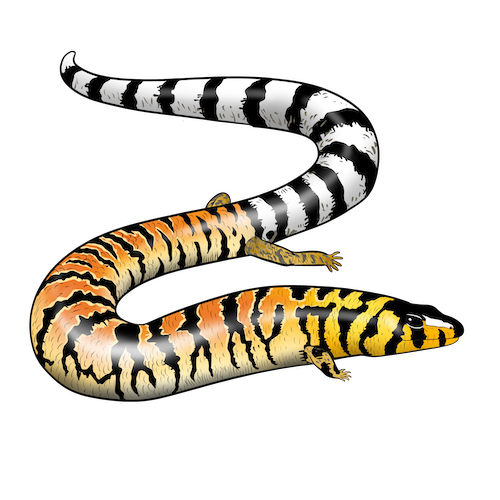In July of 2023 a friend and former co-worker texted me a question:
“Hey, would you be interested in a caiman lizard?”

In truth, I had never considered keeping giant lizards much. I’ve always been more of a small reptile and amphibian guy, with a focus on things like newts that can live comfortably in twenty gallon tanks. Caiman lizards are closely related to the much more popular pet lizards, the tegus, which also get roughly three or four feet long usually. Tegus are known for being intelligent and generally pretty tame-able, but they are also more generalist lizards, being omnivorous, terrestrial and more or less easy to care for providing you have the room. (That’s a big if, though, admittedly).

If you know anything about me, though, you know that when someone offers me a free lizard, I accept. I’ve always been a sucker for taking in animals. As a kid, my very Catholic dad often jokingly called me St. Francis, because I was always coming home with some creature in need that I had found. Once, a bird just came up to me as I was walking the neighborhood and hopped onto my foot. So, needless to say, a long and storied history of accepting wayward creatures. And when you’ve been the local-lizard-accepter-guy for that long, people sometimes text you and ask if you want a free caiman lizard.
Now, I’m not going to name and shame or anything here, but it was clear when Neel was brought to me that he wasn’t in the best overall situation. Caiman lizards are from South America, and are not generally captive bred, but they are farmed for the pet trade and for their leather. When they’re imported into the U.S., they’re usually babies. I’d guess that he was probably about a year old and I think his previous owner had tried to do her best. Caiman lizard babies are about a foot long and most of that is tail. She said she had been keeping him in a 75 gallon aquarium (which is about 4 feet long), so for a baby, not bad, but he was definitely under weight. This could be in part because caiman lizards, particularly baby caiman lizards eat snails.
Yeah, I forgot to mention that part. Those big jaws? Their weird, molar-like teeth? For crushing aquatic snails and spitting out the shells. There are a few reptile supply companies that sell canned, pre-shelled snail meat, at exorbitant prices, and I expect he wasn’t being fed as frequently as he needed to be.

I took Neil home and got to work. I didn’t have anything big enough for him yet, so I had to improvise a temporary enclosure for him. Caiman lizards love to climb and spend a good chunk of the day basking on tree branches that overhang fresh water. When they aren’t doing that, they’re in the water, swimming. So he was going to need, essentially, a gigantic paludarium. Like a newt setup, only room-sized.
The only thing he fit into for the moment was another 4 foot tank I had on hand, but I needed to handle the water so I started brainstorming. For now, I was also giving him access to the bath tub, so he could fully soak and submerge and get some of his stuck shed off.
I tried offering Neil a few different snail options and I think initially he was too freaked out to eat. That’s normal for lizards in new environments, so I wasn’t worried but I was frantically doing research on what these guys eat in the wild, you know, besides snails. And where I might be able to get more snails. The snails they prey on are Pomacea — the genus that includes the wildly invasive apple snails, once a staple of the aquarium hobby and now mostly supplanted by their close but smaller cousins the mystery snails”. I keep a lot of aquariums, and have a pretty healthy population of mystery snails. I tried offering live mystery snails to Neel, but he looked at me like I was offering him a bucket of rusty screws.
The first meal I got him to accept was actually, of all things, canned papaya, sold as something tegus seem to like. He ate it happily. Next, I found the local asian grocery shop carried frozen snails at a fraction of the cost of the “for reptiles” canned snails. Sometimes frozen mystery snails, sometimes saltwater snails, aka winkles. Neel accepts both, but definitely prefers the mystery snail meat.

Once we got the food situation figured out, I got to work on his permanent enclosure. I found the best way to maximize space and still be able to control temperature and humidity was a grow tent, marketed and sold to folks wanting to grow certain recreational type plants. This provided a walk in, room-sized enclosure, that was secure, stable and affordable! I think I spent less than $200 total on the grow tent. I also managed to clean up and fix up an 80 gallon pond for Neel to swim in.

In the two years we’ve had Neel, he’s become part of the family. During the warmer months he enjoys sitting outside with us, and when he can’t be outside he seems to enjoy being with us indoors. He does go a bit crazy when I enter his enclosure to feed him (we do a daily ritual where I have to show him my hand and let him flick his tongue to remind him that I am not, in fact, made of snails), and he has about doubled in size and still seems to be growing.

I wouldn’t say these lizards are for just any reptile hobbyist. Or even most. The amount of equipment, space and time/money is probably prohibitive for most people. But I’m glad Neel came to us. He’s smart, friendly (provided you aren’t a snail), and unique.

Leave a Reply